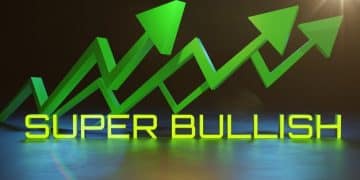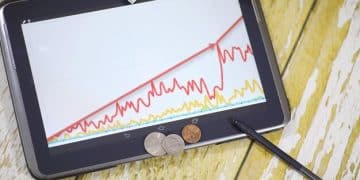How 2.8% GDP Growth in 2025 Impacts Your Investments

A projected 2.8% GDP growth in 2025 suggests a strengthening economy that could influence a broad spectrum of investments, including equities, bonds, and real estate, contingent on inflation and interest rate responses.
The economic landscape is a dynamic tapestry, with threads woven through global events, fiscal policies, and consumer behavior. As we look towards 2025, a projected 2.8% GDP growth in 2025 signals a notable expansion, prompting investors to consider how this vital economic indicator will reshape their portfolios. Understanding the multifaceted implications of such growth is crucial for strategic decision-making, offering both opportunities and potential challenges across various asset classes.
Decoding GDP Growth and Its Economic Significance
Gross Domestic Product (GDP) serves as the primary gauge for measuring a nation’s economic health, reflecting the total monetary value of all finished goods and services produced within its borders over a specific period. A projected 2.8% growth rate for 2025, especially following periods of volatility, suggests a robust and expanding economy. This figure is not merely a number; it represents increased production, higher employment rates, and potentially stronger consumer spending.
When GDP grows consistently, it generally indicates a healthy economic environment. Businesses thrive, expanding operations and creating jobs. Consumers, feeling more secure in their employment and income, tend to spend more, further stimulating demand. This virtuous cycle often leads to higher corporate profits, which can then translate into increased stock valuations and improved market sentiment. However, the nature of this growth — whether driven by consumption, investment, government spending, or net exports — can have varying impacts.
Understanding the Components of GDP
GDP is typically broken down into four main components: consumption, investment, government spending, and net exports. Each component provides insights into the driving forces behind the overall growth. For instance, strong consumer spending indicates confidence and stable household incomes, crucial for sectors like retail and services. Increased business investment, on the other hand, points to companies betting on future demand and productivity gains.
- Consumption (C): This is the largest component, reflecting household spending on goods and services. A healthy increase here signals consumer confidence.
- Investment (I): Business spending on capital goods, inventory, and residential construction. It indicates future productive capacity.
- Government Spending (G): Expenditures by federal, state, and local governments on goods and services. Can provide stability during economic downturns.
- Net Exports (NX): The difference between exports and imports. A positive value contributes to GDP, while a negative value detracts.
The projected 2.8% growth for 2025 suggests that these components are expected to perform well collectively. This could mean a broad-based economic strengthening rather than growth concentrated in just one or two sectors. Such balanced growth tends to be more sustainable and less prone to sudden shifts, offering a more predictable environment for investors. It also suggests that the underlying fundamentals of the economy are strong, potentially absorbing any minor shocks without significant disruption. The balance between these components can reveal where the economy’s momentum truly lies, offering valuable clues for sectoral investment strategies.
Impact on Equities: Will Your Stocks Soar?
For many investors, the immediate question regarding GDP growth relates to the stock market. A projected 2.8% GDP increase typically bodes well for equity performance. Strong economic growth generally translates into higher corporate revenues and profits, which are key drivers of stock prices. Companies operating in a growing economy can expand their customer base, increase sales volumes, and potentially improve their profit margins.
However, the relationship between GDP growth and stock market performance is not always direct or immediate. Markets are forward-looking mechanisms, often pricing in anticipated economic conditions well in advance. Therefore, some of the expected 2.8% growth might already be factored into current stock valuations. The true impact will depend on whether the actual growth meets, exceeds, or falls short of these projections, and how it compares to market expectations.
Sectoral Opportunities and Risks
Within the equities market, certain sectors are likely to benefit more disproportionately from robust GDP growth. Cyclical industries, such as consumer discretionary, industrials, and financials, tend to perform strongly during periods of economic expansion. These sectors are highly sensitive to the economic cycle, experiencing increased demand for their products and services as consumer spending and business investment rise.
- Consumer Discretionary: Increased consumer confidence and disposable income can boost sales of non-essential goods and services, from automobiles to luxury items.
- Industrials: As businesses expand and infrastructure projects gain momentum, demand for manufacturing, machinery, and transportation services typically surges.
- Financials: Higher economic activity often leads to increased lending, more robust capital markets, and greater demand for financial services, benefiting banks and investment firms.
- Technology: While often considered growth stocks regardless of the cycle, a strong economy can accelerate digital transformation efforts across industries, increasing demand for software, hardware, and IT services.
Conversely, defensive sectors, such as utilities, consumer staples, and healthcare, might see more moderate gains. These sectors tend to be less volatile during economic upswings but also offer less upside during booming periods. Investors should re-evaluate their asset allocation to balance exposure to growth-oriented sectors with the stability offered by defensive plays, depending on their risk tolerance and investment objectives. While growth is positive, it can also lead to inflationary pressures or tighter monetary policy, which could temper equity gains, making careful selection paramount.
Fixed Income Implications: Bonds in a Growing Economy
The relationship between economic growth and fixed income, particularly bonds, is often inverse to that of equities. While strong GDP growth is generally positive for stocks, it can present challenges for bondholders. The projected 2.8% GDP growth in 2025 might lead to expectations of higher inflation and, consequently, a less accommodative monetary policy from central banks. This typically translates into rising interest rates, which can devalue existing bonds.
When interest rates rise, newly issued bonds offer higher yields, making older bonds with lower yields less attractive. This pressure can cause bond prices to fall, leading to capital losses for investors who sell before maturity. The duration of a bond—its sensitivity to interest rate changes—becomes a critical factor. Longer-duration bonds are more susceptible to interest rate risk than shorter-duration bonds.
Navigating Rising Yields and Inflationary Pressures
A growing economy can induce inflationary pressures as demand outstrips supply and wage growth accelerates. Inflation erodes the purchasing power of fixed income payments, making bonds less appealing. Central banks, in response, often raise benchmark interest rates to curb inflation, further impacting bond yields. For investors in 2025, a careful assessment of inflation expectations and the Federal Reserve’s stance will be paramount.
- Shorter-duration bonds: These may be preferable in a rising rate environment as they are less sensitive to interest rate changes.
- Inflation-Protected Securities (TIPS): These bonds offer protection against inflation, as their principal value adjusts with the Consumer Price Index (CPI), making them more attractive during inflationary periods.
- Floating-rate notes: These securities have interest payments that adjust periodically with a benchmark rate, offering some protection against rising rates.
Conversely, if the 2.8% GDP growth is accompanied by low inflation, the impact on bonds could be milder, or even positive if it signifies robust economic health without overheating. However, the general consensus is that sustained growth often leads to some level of inflationary pressure. Diversifying within the fixed-income portfolio by incorporating different types of bonds, considering bond ladders, or exploring alternative fixed-income assets can help mitigate risks. Careful monitoring of inflation data and central bank communications will be crucial for fixed income investors seeking to preserve capital and generate returns in 2025.

Real Estate and Commodities: Potential Beneficiaries of Growth
Economic growth often spills over into real estate and commodity markets, offering distinct investment opportunities. A projected 2.8% GDP growth typically fosters an environment conducive to real estate appreciation, driven by increased demand for housing, commercial spaces, and industrial properties. As the economy expands, employment rises, leading to stronger demand for residential units, while businesses need more office and retail spaces to accommodate their growth.
Commercial real estate, in particular, can see a boost from an expanding economy. Higher corporate profits encourage businesses to invest in new facilities or expand existing ones, driving up rental income and property values. Industrial real estate, such as warehouses and logistics centers, also benefits as e-commerce grows and supply chains expand to meet increased consumer demand. Residential real estate also thrives on job creation and rising wages, which enhance affordability and homebuyer confidence.
Commodities: Fueling Economic Expansion
The relationship between GDP growth and commodity prices is usually direct. A growing economy implies higher industrial activity, increased construction, and greater consumer spending, all of which drive up demand for raw materials. Commodities such as crude oil, industrial metals (copper, iron ore), and agricultural products tend to experience price increases during periods of robust economic growth.
- Energy Commodities: As economic activity increases, so does the demand for energy, benefiting oil, natural gas, and refined petroleum products.
- Industrial Metals: Construction, manufacturing, and infrastructure projects require significant inputs of metals, driving their prices higher.
- Agricultural Commodities: Increased disposable income and population growth can lead to higher demand for food and other agricultural products.
However, commodity markets are also influenced by supply-side factors, geopolitical events, and environmental regulations. While strong GDP growth provides a tailwind, investors must consider these additional variables. Diversification across different commodities or investing through commodity-related ETFs can provide exposure while mitigating specific commodity risks. Real estate and commodities can act as hedges against inflation in a growing economy, offering tangible assets that may appreciate as the cost of living rises.
Navigating Inflation and Interest Rates in 2025
While a 2.8% GDP growth projection for 2025 is largely positive, it brings with it the inherent challenge of managing inflation and the associated policy responses from central banks. Strong economic expansion can lead to increased demand for goods and services, potentially outstripping supply and pushing prices upward. Wage growth, driven by tighter labor markets, can also contribute to inflationary pressures, as businesses pass on higher labor costs to consumers.
Central banks, notably the Federal Reserve in the U.S., closely monitor inflation metrics. If inflation accelerates beyond their target levels (typically around 2%), they are likely to respond by raising interest rates. Higher interest rates are designed to cool down the economy by making borrowing more expensive, thereby reducing consumer spending and business investment. This delicate balancing act—promoting growth without igniting runaway inflation—will be a key theme for investors in 2025.
Monetary Policy and Investment Strategy
The Federal Reserve’s actions will significantly influence the investment landscape. A more restrictive monetary policy, characterized by higher rates, can impact various asset classes differently. While it might temper equity valuations by increasing borrowing costs for companies and making fixed-income investments more attractive in relative terms, it is also a sign of an economy strong enough to withstand such measures.
- Equity Impact: Higher interest rates can reduce corporate profitability by increasing debt servicing costs and may lower the present value of future earnings, potentially leading to lower stock valuations.
- Bond Impact: As discussed, rising rates generally depress bond prices, especially for longer-duration bonds.
- Real Estate Impact: Higher mortgage rates can reduce housing affordability and demand, potentially slowing down real estate appreciation.
- Currency Impact: Higher interest rates can strengthen the domestic currency, which might make exports less competitive but imports cheaper.
Investors should carefully monitor economic data, particularly inflation reports and employment figures, as well as statements and minutes from central bank meetings. Adapting investment strategies to anticipated interest rate movements will be crucial. This might involve shortening bond durations, favoring companies with strong balance sheets and less reliance on debt, or exploring alternative investments that are less sensitive to interest rate fluctuations. Understanding the nuanced interplay between GDP growth, inflation, and monetary policy will be essential for making informed investment decisions in 2025.
Diversification and Risk Management in a Growing Economy
While a projected 2.8% GDP growth in 2025 paints an optimistic picture, it’s critical for investors to remember that economic forecasts are not guarantees. Unexpected geopolitical events, unforeseen supply chain disruptions, or policy shifts can quickly alter the economic trajectory. Therefore, maintaining a diversified portfolio and employing robust risk management strategies remain paramount, even in a seemingly favorable economic climate.
Diversification involves spreading investments across various asset classes, sectors, geographies, and investment styles. This approach helps mitigate the impact of underperformance in any single area. For instance, while equities may thrive, bonds could face headwinds, or vice versa. A well-diversified portfolio aims to capture gains from different market segments while cushioning against losses from others, ensuring a smoother ride through market volatility.
Beyond Traditional Asset Classes
Consider looking beyond traditional stocks and bonds. Alternative investments, such as private equity, hedge funds, or real assets, can offer different risk-return profiles and correlations to traditional markets. These can provide additional diversification benefits and potentially enhance returns, though they often come with higher liquidity risks and investment minimums. Additionally, exploring international markets can provide exposure to different growth cycles and reduce reliance on a single economy’s performance.
- Geographic Diversification: Investing in economies with different growth drivers can reduce country-specific risks.
- Asset Class Diversification: Combining equities, fixed income, real estate, and commodities to balance risk and return.
- Sectoral Diversification: Avoiding overconcentration in a single economic sector, even those projected to perform well.
- Investment Style Diversification: Blending growth, value, and income-oriented investments to capture opportunities across different market conditions.
Effective risk management also involves setting clear investment goals, understanding your risk tolerance, and regularly rebalancing your portfolio. Rebalancing ensures that your asset allocation remains aligned with your long-term objectives, preventing any single asset class from disproportionately dominating your portfolio due to strong performance. Furthermore, maintaining an emergency fund and avoiding over-leveraging are fundamental personal finance principles that become even more critical during periods of economic transition or uncertainty. Proactive risk management, rather than reactive measures, is key to sustained investment success.
Long-Term Investment Outlook Beyond 2025
While the 2.8% GDP growth projection for 2025 provides a snapshot of short-term economic prospects, successful investing necessitates a long-term perspective. Economic cycles are inherently dynamic, characterized by periods of expansion, contraction, and recovery. What might be an optimal strategy for 2025 could require adjustments as economic conditions evolve in subsequent years. Therefore, understanding the broader trends and foundational elements driving economic growth is crucial for building a resilient portfolio.
Long-term investment success is rarely about timing the market or relying on short-term forecasts alone. Instead, it hinges on consistent asset allocation, disciplined investing, and a deep understanding of macroeconomic forces. Future GDP trajectories will be shaped by factors such as technological innovation, demographic shifts, global trade dynamics, and climate change policies. These secular trends can create new industries, disrupt existing ones, and reallocate capital over decades, rather than just years.
Adaptability and Continuous Learning
The investment landscape is constantly changing, making adaptability a core competency for long-term investors. Staying informed about emerging technologies, evolving consumer behaviors, and geopolitical developments will be vital. For instance, advancements in artificial intelligence, renewable energy, and biotechnology are not just short-term trends; they are foundational shifts that will reshape economies well beyond 2025.
- Technological Innovation: Investigate companies at the forefront of AI, biotech, and clean energy, which can drive productivity and create new markets.
- Demographic Shifts: Consider industries benefiting from aging populations (healthcare, elder care) or growing younger demographics (education, consumer goods in emerging markets).
- Global Interconnectedness: Understand how international trade agreements, currency fluctuations, and geopolitical stability can impact cross-border investments.
- Sustainable Investing: Environmental, Social, and Governance (ESG) factors are increasingly influencing corporate performance and investor preferences, offering long-term growth potential and risk mitigation.
Ultimately, a robust long-term investment strategy is not about predicting specific events but about building a portfolio that can withstand various economic scenarios and adapt to unforeseen challenges. It involves regularly reviewing your financial goals, assessing your risk tolerance, and rebalancing your portfolio to align with your long-term vision. The 2.8% GDP growth in 2025 is an encouraging sign, but sound investment principles, grounded in a long-term perspective and continuous learning, will truly secure your financial future.
| Key Point | Brief Description |
|---|---|
| 📈 Equity Impact | Strong GDP growth generally boosts corporate profits, potentially leading to higher stock valuations, especially in cyclical sectors. |
| 📉 Fixed Income | Increased growth may lead to higher inflation and interest rates, which can devalue existing bonds, favoring shorter durations. |
| 🏠 Real Estate & Commodities | Economic expansion typically drives demand and appreciation in real estate and increases prices for raw materials like oil and metals. |
| 🛡️ Risk Management | Diversification across asset classes and close monitoring of inflation and central bank policies are crucial for mitigating risks. |
Frequently Asked Questions About 2025 GDP Growth and Investments
A 2.8% GDP growth forecast typically indicates a strengthening economy, which is generally positive for investments. It suggests increased corporate earnings, improved consumer spending, and potential for asset appreciation across various sectors. However, it also brings considerations around inflation and interest rate adjustments that can influence different asset classes uniquely.
Cyclical sectors such as consumer discretionary, industrials, and financials are often strong beneficiaries of robust GDP growth. These industries thrive when consumer confidence is high and business investment increases. Technology firms also tend to benefit from economic expansion as businesses and consumers upgrade systems and invest in innovation.
Strong GDP growth can lead to higher inflation and subsequent interest rate hikes by central banks. This environment typically reduces the value of existing bonds, especially longer-duration ones, as newly issued bonds offer higher yields. Investors might consider shorter-duration bonds or inflation-protected securities to navigate these conditions.
Generally, yes. Increased economic activity and employment drive demand for both residential and commercial real estate, potentially leading to appreciation. Similarly, higher industrial production and consumer demand resulting from growth typically boost prices for commodities like oil, industrial metals, and agricultural products.
While positive, strong growth carries risks such as rising inflation, which could lead to tighter monetary policies and higher interest rates. Geopolitical instability, supply chain disruptions, and unexpected global events could also alter the economic trajectory. Diversification and careful risk management are crucial to navigate these potential challenges effectively.
Conclusion
The projected 2.8% GDP growth for 2025 paints an encouraging picture for the U.S. economy, promising a period of sustained expansion that could significantly influence investment portfolios. While equities, real estate, and commodities stand to benefit from increased consumer confidence and business activity, fixed income markets may face headwinds from potential interest rate adjustments and inflationary pressures. Navigating this dynamic landscape requires a nuanced approach, emphasizing careful asset allocation, strategic diversification, and a vigilant eye on macro-economic indicators, particularly inflation and central bank policies. Ultimately, understanding the intricate relationship between economic growth and market dynamics empowers investors to make informed decisions, positioning their portfolios for resilience and long-term success.





